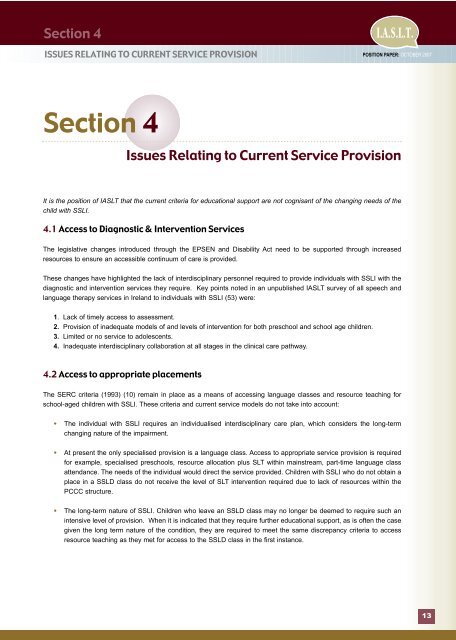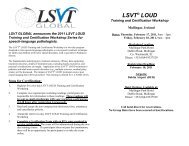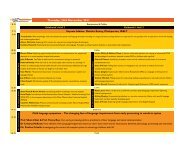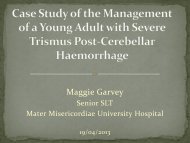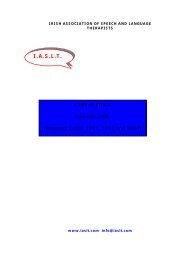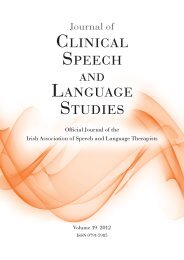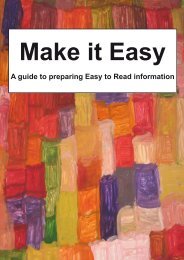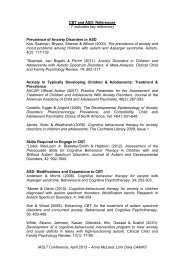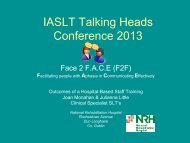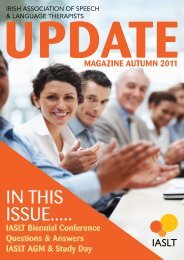Specific Speech and Language Impairment in Children - Irish ...
Specific Speech and Language Impairment in Children - Irish ...
Specific Speech and Language Impairment in Children - Irish ...
- No tags were found...
You also want an ePaper? Increase the reach of your titles
YUMPU automatically turns print PDFs into web optimized ePapers that Google loves.
Section 4ISSUES RELATING TO CURRENT SERVICE PROVISIONI.A.S.L.T.POSITION PAPER: OCTOBER 2007Section 4Issues Relat<strong>in</strong>g to Current Service ProvisionIt is the position of IASLT that the current criteria for educational support are not cognisant of the chang<strong>in</strong>g needs of thechild with SSLI.4.1 Access to Diagnostic & Intervention ServicesThe legislative changes <strong>in</strong>troduced through the EPSEN <strong>and</strong> Disability Act need to be supported through <strong>in</strong>creasedresources to ensure an accessible cont<strong>in</strong>uum of care is provided.These changes have highlighted the lack of <strong>in</strong>terdiscipl<strong>in</strong>ary personnel required to provide <strong>in</strong>dividuals with SSLI with thediagnostic <strong>and</strong> <strong>in</strong>tervention services they require. Key po<strong>in</strong>ts noted <strong>in</strong> an unpublished IASLT survey of all speech <strong>and</strong>language therapy services <strong>in</strong> Irel<strong>and</strong> to <strong>in</strong>dividuals with SSLI (53) were:1. Lack of timely access to assessment.2. Provision of <strong>in</strong>adequate models of <strong>and</strong> levels of <strong>in</strong>tervention for both preschool <strong>and</strong> school age children.3. Limited or no service to adolescents.4. Inadequate <strong>in</strong>terdiscipl<strong>in</strong>ary collaboration at all stages <strong>in</strong> the cl<strong>in</strong>ical care pathway.4.2 Access to appropriate placementsThe SERC criteria (1993) (10) rema<strong>in</strong> <strong>in</strong> place as a means of access<strong>in</strong>g language classes <strong>and</strong> resource teach<strong>in</strong>g forschool-aged children with SSLI. These criteria <strong>and</strong> current service models do not take <strong>in</strong>to account:• The <strong>in</strong>dividual with SSLI requires an <strong>in</strong>dividualised <strong>in</strong>terdiscipl<strong>in</strong>ary care plan, which considers the long-termchang<strong>in</strong>g nature of the impairment.• At present the only specialised provision is a language class. Access to appropriate service provision is requiredfor example, specialised preschools, resource allocation plus SLT with<strong>in</strong> ma<strong>in</strong>stream, part-time language classattendance. The needs of the <strong>in</strong>dividual would direct the service provided. <strong>Children</strong> with SSLI who do not obta<strong>in</strong> aplace <strong>in</strong> a SSLD class do not receive the level of SLT <strong>in</strong>tervention required due to lack of resources with<strong>in</strong> thePCCC structure.• The long-term nature of SSLI. <strong>Children</strong> who leave an SSLD class may no longer be deemed to require such an<strong>in</strong>tensive level of provision. When it is <strong>in</strong>dicated that they require further educational support, as is often the casegiven the long term nature of the condition, they are required to meet the same discrepancy criteria to accessresource teach<strong>in</strong>g as they met for access to the SSLD class <strong>in</strong> the first <strong>in</strong>stance.13


